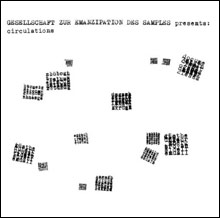
Gesellschaft Zur Emanzipation des Samples
Circulations
(Faitiche; 2009)
By Joel Elliott | 9 December 2009
As a Ryerson grad student I go to class, work, and otherwise practically live just around the corner from Toronto’s infamous Yonge-Dundas Square. I get the sense the place isn’t well-liked by people who, like myself, have to maneuver through its congested sidewalks to get where they need to be, as opposed to just coming down there to shop. Despite its massive advertisements, it will never be as immense as Times Square, not to mention the fact that it erases both the history of New York which it superficially “quotes” from, as well as Toronto itself, in the sense that the whole thing was practically reconstructed overnight.
Besides being a prime example of modern urban alienation (did I mention I’m a grad student?), Yonge-Dundas Square is an ironic place for a filmmaker to work. There is very little that can be shot without, at least theoretically, infringing on copyright, since nearly every space is filled with advertisements. While it seems relatively clear (as far as anything is clear in copyright law) that filming a copyright-protected advertisement, despite its position in a so-called “public” space, is a legal infringement, the ownership of “aural space” seems a lot muddier. This is the space which is contested in Jan Jelinek’s Gesellschaft Zur Emanzipation des Samples (Society for the Emancipation of Samples), which is both a musical project and presumably at the very least a propositional model for how loopholes in sampling laws might be found—or, barring that, a collective slush fund for fees incurred by copyright infringement on the part of the would-be organization’s members.
The two pragmatic functions of the project seem almost at odds with each other. Either Jelinek has found a legitimate loophole, or corporate money will always win and all time and energy should be devoted to allowing artists the financial means to work freely without the constraints of copyright. Jelinek admits the potential conflict in his extensive “linernotes” (read by a computer-generated voice on the last track—clearly he sees no separation between the theoretical and musical components of the project), which establish the project as “raising more questions than answers.” Jelinek’s clearly not a lawyer, and I’m not either, though I’d probably cast my lot with the latter function: it seems to me if any loophole poses a legitimate threat, then eventually it will be effectively challenged by corporate power.
If Circulations doesn’t pose a legitimate threat, it may be because its technique is too esoteric to be widely-adopted. Still, the strategy is fascinating: after hearing songs like “Born to Run” and “Sexual Healing” playing out of the P.A. of a fairground carousel, Jelinek was inspired to record popular music in various public environments, suggesting that if the recorded music just happened to be a part of the ambient noise, it might not be an infringement of copyright. At the very least, the recording goes a long way towards initiating a dialogue about the privatization of public space and the way popular music becomes a part of a social environment. “Artists” like Girl Talk have been retroactively assigned as pillars of the battle for free use of sampling, while more innovative collectors like DJ/rupture have always been about mixing global styles to advocate a kind of shared consciousness. Gesellschaft Zur Emanzipation des Samples is the first example, to my knowledge, of the battle against copyright law as an a priori rationale for a musical project.
All this will probably have the unfortunate effect of dwarfing the actual music, which is a haunting update of musique concrète, albeit constantly veering into abstraction. Opener “Laokoon, Orinoco, Oberhausen” is a woozy, funhouse mirrors trip, stringed instruments frantically racing up and down the scale with what sounds like dozens of caged animals. It doesn’t sound like pop music, but it does sound like the multitude of voices and attractions you’d witness at a carnival. “Mount Zermatt (In Dub)” is a surreal masterpiece, wherein Jelinek somehow manages to blend taut, high-tempo orchestral music into incidental dinner noises.
This abstraction is somewhat problematic, not that it doesn’t sound great, but that the numerous samples Jelinek uses are completely unidentifiable. When it does sound like other music, it recalls 20th century classical, ’50s sci-fi soundtracks and early tape collages. It’s rather banal to think that he might never have legal issues for the simple reason that it would be nearly impossible to prove those samples are in there. In that respect, when he rather abruptly announces all the popular music that lies buried underneath his music on the second track, it comes off as a bit of a provocation: perhaps an attempt to lure would-be lawsuits to prove a point, or at the very least, to underscore a relationship to the samples that would otherwise be only implicit. In the “Linernotes” the computer voice says, “We will always be able to decipher and disassociate ‘Sexual Healing’ from the random noise of public space,” and yet ironically, except for the background music on that track in particular, we can’t.
Still, whether he acknowledges it or not, the way Circulations teeters on the verge of sourcelessness is intriguing for its own reasons. The carousel is an appropriate metaphor: in the blur of movement (slowed down here, as well as sped-up) we lose the distinction between objects, and consequently what is “public” or “private.” Pre-recorded music becomes as spontaneously-generated and allusive—“belonging” to no one—as random crowd noises. All these concrete ideas begin to blur too, but that’s merely the tension inherent in any attempt to balance art and political action.





